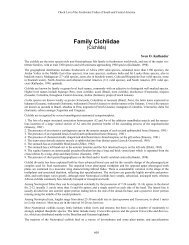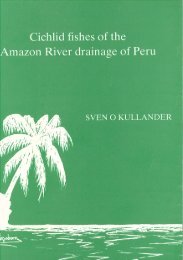Open Access PDF - Sven Kullander
Open Access PDF - Sven Kullander
Open Access PDF - Sven Kullander
Create successful ePaper yourself
Turn your PDF publications into a flip-book with our unique Google optimized e-Paper software.
confluent elongate yellow or white spots. Pelvic<br />
fin pale grey to blackish.<br />
Large male 291 mm SL from Guri (Fig. 16)<br />
unique in having horizontally elongate irregular<br />
lateral blotches 2-3 and additional small ocellar<br />
blotches along middle of side caudad to caudal-fin<br />
base connecting lateral blotches and caudal-fin<br />
blotch. Several other large specimens with occasional<br />
dark ocellar blotches associated with blotch<br />
3 or scattered on caudal peduncle. Large mature<br />
male 267 mm SL from Guri (NRM 21548), with<br />
blotch 1 roundish, blotch 2 represented by bar 1,<br />
blotch 3 irregularly shaped, none of blotches or<br />
bars ocellated, although 1 and 3 with a few marginal<br />
light spots. Large females (Fig. 17) with<br />
numerous light spots on side and caudal peduncle,<br />
opercle, subopercle, and cheek, but absent on<br />
top of head. Indistinct un-ocellated blotch 1,<br />
bars/blotches 2 and 3 absent or only indicated.<br />
Live colouration. No personal observations. In<br />
published photographs of adults (e.g., Román,<br />
1981), and Machado-Allison’s (1971) and Winemiller’s<br />
(2001) descriptions olivaceous to greyish<br />
dorsum and olivaceous to yellowish or golden<br />
side. Pelvic, anal and lower half of caudal fin<br />
orange to reddish. Iris red. Ocellar markings lined<br />
with yellow or golden.<br />
Geographical distribution. In the Amazon basin<br />
along the Rio Negro from near San Carlos de Rio<br />
Negro and from the Rio Uaupés near Mitú downstream<br />
to Manaus, and also in the lower Rio<br />
Branco, the Rio Puraquequara slightly east of the<br />
Rio Negro, and the Rio Casiquiare. Widely distributed<br />
in the Orinoco basin including the Inírida,<br />
Atabapo, Guarrojo, Guaviare, Meta, Aguaro,<br />
and Caroní rivers. Most localities are referable to<br />
blackwaters, as suggested by the restriction to<br />
Rio Negro and Rio Puraquequara in the Amazon<br />
basin, and most collecting sites in the Orinoco<br />
drainage are in blackwater rivers (Fig. 9).<br />
Local names. Saupa (Guainía: Ilha de Dapa;<br />
Humboldt, 1821), Aketshi (Tamanaco; Humboldt,<br />
1821, referring to Gilj), Pavón (Colombia, Venezuela),<br />
Pavón tres estrellas, Pavón mariposa,<br />
Pavón amarillo, Marichapa (Venezuela; Román,<br />
1981).<br />
Notes. The original description of C. orinocensis<br />
(Humboldt, 1821: 167, pl. 45 fig. 3) is apparently<br />
based on a field drawing and field notes. No<br />
Ichthyol. Explor. Freshwaters, Vol. 17, No. 4<br />
311<br />
preserved fish specimens are known from Humboldt’s<br />
collections. The description refers to four<br />
blotches of which the last on the caudal fin, arranged<br />
in a series. The blotches are described as<br />
rounded, blue-black, and margined by a golden<br />
area. The drawing shows a very elongate fish<br />
with four absolutely round dark blotches with<br />
perfectly circular light marginal rings. The unique<br />
colour pattern allows identification of the species<br />
as the one here referred to as C. orinocensis. In<br />
addition to the incompatible elongate appearance,<br />
small mouth, and other details in the figure that<br />
may be attributed to haste or an expression of<br />
artistic freedom, the dorsal-fin count is remarkable.<br />
According to Humboldt there are 54 pungent<br />
rays in the dorsal fin. Since no other fish species<br />
is known with 54 spines in the dorsal fin, the<br />
count must be an error, but at least it confirms<br />
that the dorsal fin includes spines.<br />
Humboldt (in Humboldt & Valenciennes,<br />
1821: 168) reported that he had often eaten C. orinocensis<br />
both on the Rio Orinoco and the Rio<br />
Guainía (Rio Negro), and that the drawing was<br />
made in the Guainía valley. The specimen was<br />
collected near Ilha de Dapa, said by Humboldt<br />
(1819: 472) to be located in the middle of the Rio<br />
Guainía, 12 hours by canoe to San Carlos de Rio<br />
Negro, and apparently visited on the 5th or 6th<br />
of May 1800. Despite the name, the species thus<br />
appears to have been described primarily from<br />
the Rio Negro basin. We have not been able to<br />
locate the Ilha de Dapa on maps available to us.<br />
The type specimen of C. argus, MNHN A.1042,<br />
375 mm TL, is a stuffed and mounted skin with<br />
glass eyes (Fig. 19). It shows three round brown<br />
blotches lined with silver along the middle of the<br />
side, and a small black spot at the caudal-fin base.<br />
It has about 80 scales in the E1 row and about<br />
42+41 lateral line scales. Fin counts could not be<br />
made out with confidence; although we count<br />
D. XVIII.13 like Valenciennes (in Humboldt &<br />
Valenciennes, 1821), only 15 spines can be positively<br />
identified. Valenciennes diagnosed C. argus<br />
as distinct from C. orinocensis on the basis of possession<br />
of a caudal ocellus and the dorsal-fin<br />
count, 31 instead of 54. On Humboldt’s (1821: pl.<br />
45 fig. 3) figure of C. orinocensis it looks like the<br />
last ocellus is situated on the body instead of on<br />
the caudal fin, and this may explain why Valenciennes<br />
considered C. orinocensis to lack the<br />
caudal ocellus. The dorsal-fin count provided by<br />
Humboldt for C. orinocensis is obviously erroneous<br />
(see above). The specimen is labelled as com-




